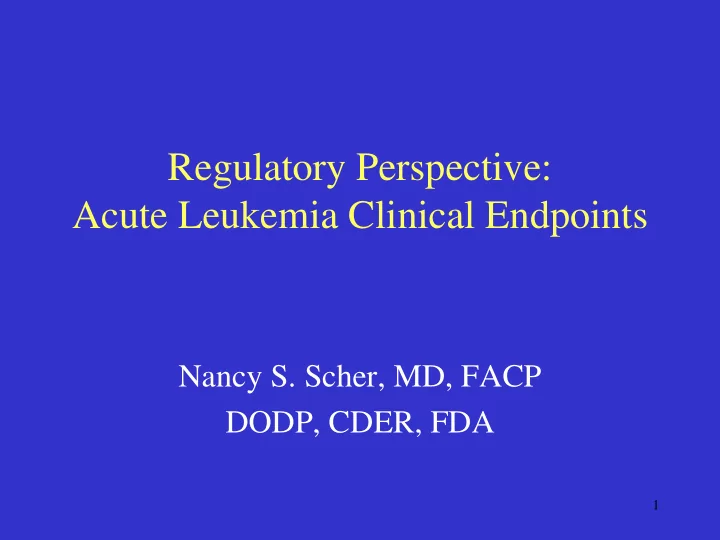

Regulatory Perspective: Acute Leukemia Clinical Endpoints Nancy S. Scher, MD, FACP DODP, CDER, FDA 1
Outline • Drug approval regulations • Regular vs. accelerated approval • Approvals for acute leukemia • Recent lessons learned – Clolar (Clofaribine) – Zarnestra (Tipifarnib) 2
Requirements for Drug Approval • Safety (FD&C Act 1938) • Efficacy (1962 amendment) – Substantial evidence – Demonstrated in adequate and well-controlled studie s • Specific indication • Defined patient population 3
Approval Pathways • Regular approval – Clinical benefit (CB) or – Established surrogate for CB • Accelerated approval (Subpart H, 1992) – Surrogate endpoint reasonably likely to predict CB 4
Regular Approval • Clinical benefit (CB) – Longer life or – “Better” life • Established surrogate for CB – e.g. Durable complete response in acute leukemia 5
Accelerated Approval • Serious or life-threatening disease • Drug provides benefit over available therapy • Surrogate endpoint reasonably likely to predict clinical benefit • Subsequent confirmation of clinical benefit is required (Post-approval commitment) 6
ENDPOINTS FOR APPROVAL DODP (1/1/90-11/1/02) • Approvals based on endpoints other than survival – All approvals: 73% (48/66) – Regular approval: 68% (39/57) – Accelerated approval (AA) 100% (14/14) • Tumor response basis for 26/57 regular approvals (plus 9/26 had relief of symptoms) • Tumor response basis for 12/14 AA • Symptom relief supported 13/57 regular approvals 7
Randomized vs. Single Arm Trials • Single arm trials have been used in relapsed disease, with AA based on response rate • Randomized trials (RT) permit evaluation of therapy in less refractory populations and variety of endpoints (Survival, TTP, QOL) • Randomization may control for population heterogeneity 8
Patient Reported Outcomes • Limitations to Tumor-Related Symptoms, Quality of Life, as Endpoint for approval – Need for validated instruments – Lack of blinding – Missing data – Differences must be clinically meaningful • Health related QOL has not been used as a basis for approval in acute leukemia 9
Acute Leukemia Approvals Indication Date Trial (s) Benefit Drug Ara-C ANLL /ALL 1969 Daunorubicin ANLL/ALL 1979 Single and CR Randomized +duration Idarubicin ANLL (first 1990 Randomized CR+dur. line comb) vs Ara-Dau Survival Teniposide Ped ALL 1992 Single Arm CR refractory +duration 10
Regular Approvals for APL, MDS Indication Date Trial (s) Drug Benefit ATRA Second 1995 Single arm CR line APL (Vesanoid) 2 cohorts 73-80% Arsenic Second 2000 Single arm CR 70% trioxide line APL Cytogen.&Dur. (Trisenox) Azacytidine MDS 2004 Randomized RR 16% (Vidaza) 2 single arm Improved 19% [AML 1/10 CR, 1/10 PR] 11
Accelerated Approvals for Acute Leukemia Drug Indication Date Trial (s) Benefit Age>60, CR + CRp Mylotarg 2000 3 single CD33+, 2 nd (16%+13%) = arm (Gemtuzumab line; can’t 30% overall ozogamicin) take chemo Relapsed/ CR + CRp Clolar 2004 Single refractory 12.2% (6/49) arm (Clofaribine) ped ALL 8.2% (4/49) 12
Mylotarg (gemtuzumab ozogamicin) • 3 single arm trials (n=142) • Adults CD33 + AML in first relapse • Overall 3 trials: CR+CRp (16+13%) = 30% • Age >60 (n=80): CR+CRp (15+11%)=26% • CRp=Platelet recovery <100,000/µL • AA: Age > 60 + aggressive Rx unsuitable • Post-marketing safety concerns 13
Clolar (clofaribine) • Relapsed/refractory pediatric ALL • Approved on CR+CRp in single arm trial • Early transplant – Responses often not confirmed (no 2 nd BM) – Duration of CR not confirmed • CR+CRp: Surrogate reasonably likely to predict CB • Can “bridge to transplant” be a surrogate? 14
Zarnestra (tipifarnib) • Proposed: Treatment of elderly patients with newly diagnosed poor-risk AML • Single arm trial(s) • Age > 75 or age 65-74 with prior MDS • CR 11% (15/135) • MDR 275 days ( 95% CI 127-376) • Mortality 1-month 12%; Rx-related deaths 7% • ODAC 5/05: Heterogenous population 15
Summary • Regular approval – Clinical benefit (CB) – Effect on Established surrogate for CB [CR+Duration] • Accelerated Approval – Effect on Surrogate reasonably likely to predict CB [CR+CRp] • Challenges – Trial design – Endpoints 16
Summary 2 • Challenges – Trial design • Single arm trial limitations • Population not defined/heterogeneous • Confounding effect of transplant – ENDPOINTS 17
Summary 3 • Challenges: ENDPOINTS – Traditional • Magnitude and duration of CR • Quality of CR (e.g. CRi, CRp) – Patient Reported Outcomes (QOL) – Advances in Biology and Molecular Genetics • Molecular CR (MRD) • Cytogenetic CR 18
Recommend
More recommend